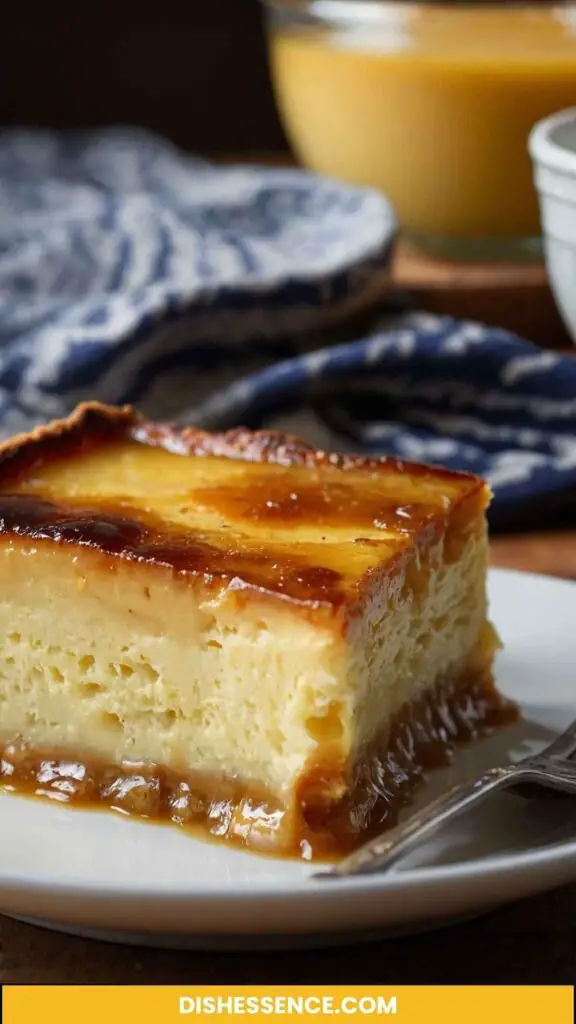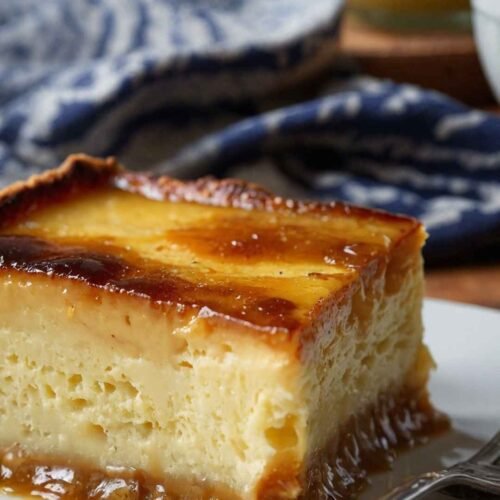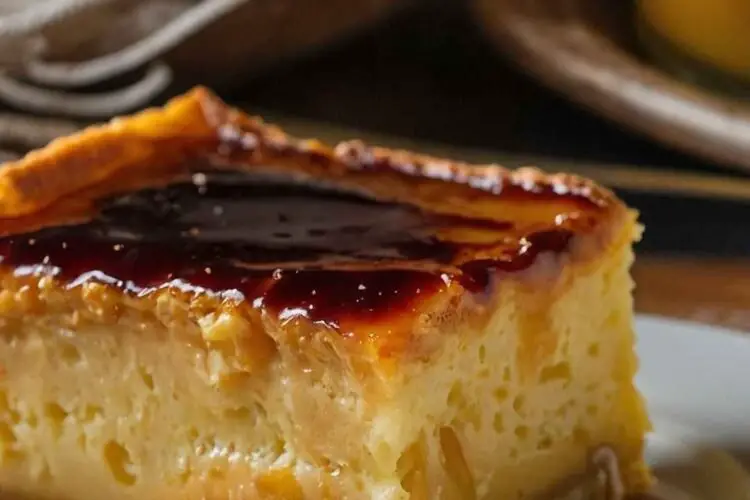Before we dive into the delicious world of Far Breton, let’s talk pairings. This French pastry is rich and custardy, making it a delightful centerpiece for any gathering. It shines brightest with a light accompaniment.
Consider serving it with a scoop of fresh whipped cream or a dollop of crème fraîche to balance the richness. A sprinkle of fresh berries—raspberries or blueberries—will add a touch of tartness.
For drinks, a chilled dessert wine like a Muscat pairs nicely, enhancing the flavors of the figs or prunes in the flan. If you prefer something non-alcoholic, a sparkling elderflower drink can provide a refreshing contrast.
Let’s jump into the delightful journey of making this special dessert!

You’ll Also Like These Recipes
Greetings, fellow food enthusiasts! Today, I’m thrilled to share a recipe that dances its way into my heart (and stomach) every time I make it: Far Breton Flan, a creamy and rich pastry hailing from Brittany, France. The texture is thick yet smooth, and the taste? Well, it’s simply divine. Imagine biting into a custardy slice dotted with sweet, soft prunes or figs. Perfect, right?
Far Breton isn’t just a dessert; it’s a reminder of rustic French kitchens, where home cooks find joy in simplicity and comfort. There’s something so comforting about this dish. Whether you serve it at a summertime picnic or cozy winter gathering, it brings people together.
What is Far Breton Flan?
Now, let’s unwrap what Far Breton really is. This flan, or custard pie, is traditionally made with eggs, flour, and milk, creating a thick mixture that’s both satisfying and indulgent. The classic version includes prunes, but you can swap in other fruits like figs or cherries. It’s baked until golden brown, transforming the simple ingredients into a luscious dessert that’s both simple and sophisticated.
Far Breton’s appeal lies in its versatility. Some people serve it warm, while others prefer it chilled. Either way, it’s a treat that feels like a hug from the inside.
How Does It Taste?
The taste of Far Breton is an experience in itself. Picture this: a rich, creamy texture envelops your taste buds as you bite into the flan. The sweetness of the prunes adds depth and a bit of chewiness. Each mouthful bursts with flavor—vanilla, orange zest, and a hint of rum. It’s a delicate balance between comforting custard and fruity brightness.
If you’ve ever enjoyed a classic bread pudding, you’d find similarities. However, Far Breton stands out with its buttery notes and slightly chewy bits from the fruit. It’s sweet, but not overwhelmingly so.
Why You’ll Love This?
You’ll adore Far Breton for several reasons. First, it requires just a few simple ingredients. Most of us have these staples lying around our kitchens already. Having a recipe that combines ease and flavor? That’s a win in my book.
Second, it’s a flexible dessert. Throw in your favorite dried fruits, or even nuts if you’re feeling adventurous. This flan is very accommodating to personal tastes.
Lastly, let’s not forget its charming presentation. A perfectly baked flan cuts beautifully into slices, making it look like you spent hours in the kitchen—when, really, you didn’t!
Ingredients
Gather these ingredients to create the magic:
- 1 tablespoon light brown sugar: This adds a warm flavor that deepens the taste without being overpowering.
- 1 liter (4 ¼ cups) whole milk: The creamy base you’ll need for that luscious texture.
- 160 grams (2/3 cup) unsalted butter, melted and cooled: For richness and flavor.
- 1 teaspoon finely grated orange zest: This provides a spark of citrus brightness.
- 250 grams (2 cups) all-purpose flour, sifted: Essential for structure.
- 6 large eggs: These bind everything together.
- 25–30 soft, pitted prunes: The traditional star, sweet and slightly chewy.
- 1 pinch fine sea salt: It enhances all flavors.
- 1 teaspoon pure vanilla extract: For that comforting, familiar flavor.
- 1 shot dark or spiced rum: It adds depth and a hint of warmth.

Step by Step Directions
Step 1: Preheat the Oven
Before you do anything else, preheat your oven to 350°F (175°C). This allows for even baking later. Grab your favorite baking dish and lightly grease it with butter or cooking spray.
Step 2: Prepare the Prunes
If you’re opting for prunes, chop them into smaller pieces (if they’re large). This helps distribute them evenly throughout the flan. You can also soak them in warm water or rum for about 10 minutes for added moisture.
Step 3: Mix the Dry Ingredients
In a large bowl, combine the sifted flour, brown sugar, and salt. Give it a quick whisk to make sure everything is well mixed. This eliminates clumps and ensures an even inside texture.
Step 4: Whisk the Wet Ingredients
In another bowl, whisk together the eggs, milk, melted butter, vanilla extract, and orange zest. Mix until everything is combined—don’t be afraid to channel your inner whisking champion.
Step 5: Combine Wet and Dry Ingredients
Slowly, add the wet mixture to the dry mixture, stirring gently. You want to combine these without overworking the batter. If you’re feelin’ fancy, pour through a sieve to ensure a velvety consistency.
Step 6: Fold in the Prunes
Gently fold the prunes into the batter. It’s important to do this carefully so that you don’t break the prunes apart.
Step 7: Pour and Bake
Pour the batter into your greased baking dish. Bake in the preheated oven for about 50-60 minutes. You’ll know it’s done when an inserted knife comes out clean, or with tiny crumbs attached.
Step 8: Cool Down and Serve
Allow the flan to cool at room temperature for about 15-20 minutes before slicing. Serve warm or chilled, depending on your preference. Pair it with whipped cream or fresh berries as we discussed earlier.
Tips On Making Far Breton Flan
- Choose Quality Ingredients: Don’t skimp on freshness. Quality eggs and milk make a noticeable difference.
- Don’t Overmix: Just combine wet and dry until you see no more flour clumps; overmixing could result in a dense texture.
- Experiment with Fruits: Feel free to swap out prunes for figs, cherries, or even apples. You can tailor it to what you or your guests enjoy.
- Baking Dish Matters: A glass or ceramic dish tends to bake the flan evenly. This can prevent any soggy bottoms.
- Serve It Right: Letting it cool completely before slicing helps it hold its shape better. Patience pays off!
Nutrition Information
Far Breton is rich, and like most desserts, it should be enjoyed in moderation. Here’s a quick glance at the nutrition per serving (about 1/8 of the flan):
- Calories: 320
- Total Fat: 17 g
- Saturated Fat: 10 g
- Cholesterol: 120 mg
- Carbohydrates: 38 g
- Dietary Fiber: 2 g
- Sugars: 15 g
- Protein: 7 g
How Do You Store This Far Breton Flan Recipe?
Storing leftover Far Breton couldn’t be easier. Cover the flan tightly with plastic wrap or transfer to an airtight container. It will keep nicely in the refrigerator for about 3-4 days.
For longer storage, you can freeze slices. Wrap each piece in plastic wrap, then aluminum foil, and pop into the freezer. It’ll last for about 2-3 months, but let’s be honest, it rarely lasts that long! Just thaw in the fridge overnight before enjoying.

What Other Substitutes Can You Use in Far Breton Flan Recipe?
If you’re itching to put your spin on Far Breton or need to work with what’s in your pantry, here are some substitutes you can consider:
- Dried Apricots: These add a fruity sweetness and pair well with the custard.
- Almond Milk: If you need a dairy-free option, almond milk works, though it may alter the taste slightly.
- Maple Syrup: Instead of light brown sugar, try maple syrup for a distinct flavor twist.
- Coconut Oil: Another dairy-free swap, use coconut oil instead of butter for a tropical essence.
- Flax Eggs: To make this recipe vegan, you can use flax eggs in place of regular eggs (1 tablespoon flaxseed meal + 2.5 tablespoons water per egg).

Far Breton Flan French Pastry Recipe
Equipment
- Oven, Bowl
Ingredients
- 1 tablespoon light brown sugar: This adds a warm flavor that deepens the taste without being overpowering.
- 1 liter 4 ¼ cups whole milk: The creamy base you’ll need for that luscious texture.
- 160 grams 2/3 cup unsalted butter, melted and cooled: For richness and flavor.
- 1 teaspoon finely grated orange zest: This provides a spark of citrus brightness.
- 250 grams 2 cups all-purpose flour, sifted: Essential for structure.
- 6 large eggs: These bind everything together.
- 25 –30 soft pitted prunes: The traditional star, sweet and slightly chewy.
- 1 pinch fine sea salt: It enhances all flavors.
- 1 teaspoon pure vanilla extract: For that comforting familiar flavor.
- 1 shot dark or spiced rum: It adds depth and a hint of warmth.
Instructions
Step 1: Preheat the Oven
- Before you do anything else, preheat your oven to 350°F (175°C). This allows for even baking later. Grab your favorite baking dish and lightly grease it with butter or cooking spray.
Step 2: Prepare the Prunes
- If you’re opting for prunes, chop them into smaller pieces (if they’re large). This helps distribute them evenly throughout the flan. You can also soak them in warm water or rum for about 10 minutes for added moisture.
Step 3: Mix the Dry Ingredients
- In a large bowl, combine the sifted flour, brown sugar, and salt. Give it a quick whisk to make sure everything is well mixed. This eliminates clumps and ensures an even inside texture.
Step 4: Whisk the Wet Ingredients
- In another bowl, whisk together the eggs, milk, melted butter, vanilla extract, and orange zest. Mix until everything is combined—don’t be afraid to channel your inner whisking champion.
Step 5: Combine Wet and Dry Ingredients
- Slowly, add the wet mixture to the dry mixture, stirring gently. You want to combine these without overworking the batter. If you’re feelin’ fancy, pour through a sieve to ensure a velvety consistency.
Step 6: Fold in the Prunes
- Gently fold the prunes into the batter. It’s important to do this carefully so that you don’t break the prunes apart.
Step 7: Pour and Bake
- Pour the batter into your greased baking dish. Bake in the preheated oven for about 50-60 minutes. You’ll know it’s done when an inserted knife comes out clean, or with tiny crumbs attached.
Step 8: Cool Down and Serve
- Allow the flan to cool at room temperature for about 15-20 minutes before slicing. Serve warm or chilled, depending on your preference. Pair it with whipped cream or fresh berries as we discussed earlier.
Notes
- Choose Quality Ingredients: Don’t skimp on freshness. Quality eggs and milk make a noticeable difference.
- Don’t Overmix: Just combine wet and dry until you see no more flour clumps; overmixing could result in a dense texture.
- Experiment with Fruits: Feel free to swap out prunes for figs, cherries, or even apples. You can tailor it to what you or your guests enjoy.
- Baking Dish Matters: A glass or ceramic dish tends to bake the flan evenly. This can prevent any soggy bottoms.
- Serve It Right: Letting it cool completely before slicing helps it hold its shape better. Patience pays off!
Nutrition
Frequently Asked Questions
Can I make Far Breton in advance?
Yes! It actually tastes better as it sits. Prepare a day ahead and refrigerate. Just make sure to let it sit at room temperature before serving.
What’s the difference between Far Breton and a traditional flan?
While both are custard-like, Far Breton uses flour, giving it a thicker consistency similar to a cake. Traditional flan is smoother and more gelatinous.
What if my flan cracks while baking?
Cracking can happen due to the oven’s heat level. Make sure to bake at a controlled temperature. If it cracks, just serve it with a dollop of whipped cream to cover it up!
Can I use fresh fruit instead of dried?
Fresh fruit can work, but it alters the texture and moisture levels. It’s best to stick with dried fruits which hold up better during baking.
What’s the best way to cut the flan?
Use a sharp knife dipped in water. This rinses off some of the custard and helps create a clean cut without the slices sticking.
Is this dessert gluten-free?
No, not as it is. However, you can experiment with gluten-free flour blends to create a gluten-free version of Far Breton.
Conclusion
Far Breton Flan is much more than just a dessert. It’s a delightful blend of flavors, textures, and memories that invites you to share with family and friends. I encourage you to roll up your sleeves and create this little piece of Brittany right in your kitchen. Whether you keep it traditional with prunes or get creative with substitutions, this dish promises to be a showstopper. It’s sure to become a favorite that you look forward to making again and again. So, grab those ingredients, and let’s get baking!


